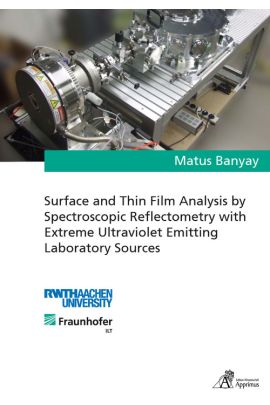Methods to investigate thin-films or surfaces using electromagnetic radiation can be traced back many decades. Some methods are even more than a hundred years old, such as ellipsometry or reflectometry. Their potential has been recognized by the industry and remained one of the main workhorses for many applications. With the invention of the laser in the 60s, more sophisticated metrology methods became available and known optical, non-destructive, techniques could be improved. Probably the worlds economically and technologically most important material so far, silicon, has created an enormous industry that is ever more in the need for laboratory based tools to characterize e.g. wafers, masks or thin-films. As the downsizing of devices continues even further, classical techniques in the visible range are reaching their limit. Hence, it becomes necessary to push some of the known methods towards shorter wavelengths well below 100 nm. The use of extreme ultraviolet radiation (XUV) enables a variety of new optical and analytical techniques, e.g. in lithography, microscopy and reflectometry. Although this radiation has been a strong domain of synchrotron sources so far, there is an increasing industrial and scientific progress in the development of laboratory-sized XUV light sources. This opens up new possibilities for in-laboratory tools mimicking some of the known techniques from accelerators and transferring them straight to the user. In this work, spectroscopic reflectometry based on laboratory extreme ultraviolet sources for metrology applications is studied. A realized prototype utilizing XUV radiation from a compact plasma discharge source was built for demonstration experiments that underline the capability of the novel technique. Such a method shows great potential especially for the analysis of ultra-thin films, or interlayers, with thicknesses well below 10 nm. High sensitivity to thickness, roughness and chemical changes in the involved materials are due to the strong interaction of XUV light with matter. In summary, the results of this work confirm the suitability of a surface sensitive analysis approach, based on a nonsynchrotron XUV source, which can be particular important for new evolving technologies such as, high-k materials or OLEDs. With relatively low measuring times in the range of a few milliseconds and a sophisticated data-analysis, XUV reflectometry envisions novel industrial tools for future ex-situ or in-situ metrology.
| Autor | Banyay, Matus |
|---|---|
| Lieferzeit | 3-4 Tage |
| Gewicht | 0.24 kg |
| Erscheinungsdatum | 28.07.2011 |
Eigene Bewertung schreiben
Ergebnisse aus der Lasertechnik
Surface and Thin Film Analysis by Spectroscopic Reflectometry with Extreme Ultraviolet Emitting Laboratory Sources
ISBN: 978-3-86359-020-8
39,00 €
inkl. 7% MwSt.
Kurzbeschreibung
Methods to investigate thin-films or surfaces using electromagnetic radiation can be traced back many decades. Some methods are even more than a hundred years old, such as ellipsometry or reflectometry. Their potential has been recognized by the industry and remained one of the main workhorses for many applications. With the invention of the laser in the 60s, more sophisticated metrology methods became available and known optical, non-destructive, techniques could be improved. [...]
Auf Lager

